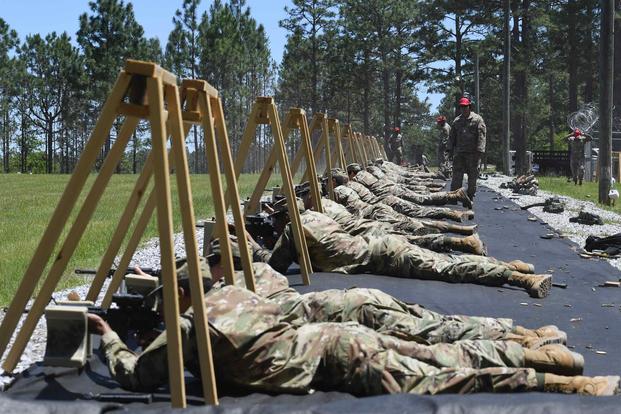The U.S. Air Force plans to use Keesler Air Force Base, Mississippi, as an alternative location for basic military training through October.
Beginning June 2, the service will accept its next incoming BMT class at Keesler and will continue to do so every week thereafter until the final week in September amid the response to the novel coronavirus, Air Education and Training Command officials announced Tuesday.
Read Next: Russia Sends Advanced Fighter Jets to Back Mercenaries in Libya
"Air Force BMT remains vital to renew the force and to the delivery of air and space power anytime, anyplace," said Maj. Gen. Andrea Tullos, 2nd Air Force commander, in the release. "Keesler's training mission is already set up with many of the facilities and procedures required to execute the mission."
The first "proof of concept" trial began in April, with 60 recruits sent to Keesler; the airmen graduated from BMT on May 15.
As a response to COVID-19, overall class sizes have been whittled down to 460 due to social distancing requirements -- with 400 going to Joint Base San Antonio-Lackland, Texas, and 60 to Keesler. Previously, groups of 650 to 800 prospective airmen would arrive at Lackland each week.
The Air Force has been gradually moving to increase its incoming class sizes while keeping safety in mind, Tullos told reporters later Tuesday.
"We stepped up to a shipment of 540 [last week]," she said in a phone call. "We will again increase up to [roughly] 700 on June 2."
The service will maintain 60 people per class at Keesler, while the remaining recruits will be based at Lackland, she added.
"The Air Force has asked us to train up to 9,400 active-duty between now and the end of the fiscal year, and a total of 12,800 total force during that time," she said. "We will meet that mark."
The recruits sent to Keesler will undergo a six-week curriculum, while those sent to Lackland will continue with a seven-and-a-half-week program, said AETC spokeswoman Jennifer Gonzalez.
The reduction to six weeks "is due to the physical layout of the BMT area, the small number of recruits, and a surge schedule, which trains airmen 10 hours per day, six days a week, versus eight hours per day," the release states.
BMT was already operating on a reduced curriculum as a result of COVID-19, down from eight-and-a-half weeks to seven-and-a-half weeks at Lackland.
Medical staff continue to screen the airmen upon arrival, who then enter a 14-day period of restricted movement, added Rob Nyquist, AETC's public health officer.
Using Keesler eliminates unnecessary transport between bases following graduation, given that the bulk of technical follow-on training for 160 career field specialty courses takes place there.
Picking those headed to Keesler is not done at random, Tullos explained. The airmen "know the career field that they have been initially selected for," she said. "This allows us to just keep them here at Keesler and get them right into their technical training."
Officials are still working out some kinks: Tullos said there were initial challenges getting the proof of concept right, such as proper uniform sizing.
"We are very meticulous about the appearance of our airmen, particularly in their blue uniforms, and we did not quite get that right," she explained. "When this [next] group of airmen come in ... we're confident that we will have that squared away."
The base is home to the 81st Training Wing, 2nd Air Force and the U.S. Air Force Reserve's 403rd Wing, the release said.
"This capability was a deliberately developed option to disperse the delivery of BMT during contingencies to provide surge capacity and introduce agility in the training pipeline construct," Tullos said. "This move also helps ensure the health and safety of our trainees and instructors by allowing proper safety controls, like physical distancing and deep cleaning."
-- Oriana Pawlyk can be reached at oriana.pawlyk@military.com. Follow her on Twitter at @Oriana0214.
Related: Air Force Shortens Recruit Training, Shifts to New Base Amid Pandemic












